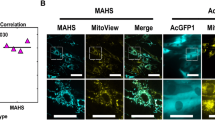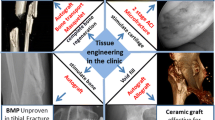Abstract
Traumatic spinal cord injury (SCI) is a major challenge in the clinic. In this study, we sought to examine the synergistic effects of linear ordered collagen scaffold (LOCS) and human placenta-derived mesenchymal stem cells (hPMSCs) when transplanted into completely transected beagle dogs. After 36 weeks observation, we found that LOCS+hPMSCs implants promoted better hindlimb locomotor recovery than was observed in the non-treatment (control) group and LOCS group. Histological analysis showed that the regenerated tissue after treatment was well integrated with the host tissue, and dramatically reduced the volume of cystic and chondroitin sulfate proteoglycans (CSPGs) expression. Furthermore, the LOCS+hPMSCs group also showed more neuron-specific βIII-tubulin (Tuj-1)- and NeuN-positive neurons in the lesion area, as well as axonal regeneration, remyelination and synapse formation in the lesion site. Additionally, dogs in the LOCS+hPMSCs group experienced enhanced sprouting of both ascending (CGRP-positive) sensory fibers and descending (5-HT- and TH-positive) motor fibers at the lesion area. All these data together suggested that the combined treatment had beneficial effects on neuronal regeneration and functional improvement in a canine complete transection model. Therefore, LOCS+hPMSCs implantation holds a great promise for bridging the nerve defect and may be clinically useful in the near future.
Similar content being viewed by others
References
Akhtar, A.Z., Pippin, J.J., and Sandusky, C.B. (2008). Animal models in spinal cord injury: a review. Rev Neurosci 19, 47–60.
Anderson, K.D. (2004). Targeting recovery: priorities of the spinal cordinjured population. J Neurotrauma 21, 1371–1383.
Assunção-Silva, R.C., Gomes, E.D., Sousa, N., Silva, N.A., and Salgado, A.J. (2015). Hydrogels and cell based therapies in spinal cord injury regeneration. Stem Cells Int doi: 10.1155/2015/948040.
Bartholomew, A., Sturgeon, C., Siatskas, M., Ferrer, K., McIntosh, K., Patil, S., Hardy, W., Devine, S., Ucker, D., Deans, R., Moseley, A., and Hoffman, R. (2002). Mesenchymal stem cells suppress lymphocyte proliferation in vitro and prolong skin graft survival in vivo. Exp Hematol 30, 42–48.
Bradbury, E.J., and McMahon, S.B. (2006). Spinal cord repair strategies: why do they work? Nat Rev Neurosci 7, 644–653.
Cao, J., Sun, C., Zhao, H., Xiao, Z., Chen, B., Gao, J., Zheng, T., Wu, W., Wu, S., Wang, J., and Dai, J. (2011). The use of laminin modified linear ordered collagen scaffolds loaded with laminin-binding ciliary neurotrophic factor for sciatic nerve regeneration in rats. Biomaterials 32, 3939–3948.
Cao, J., Xiao, Z., Jin, W., Chen, B., Meng, D., Ding, W., Han, S., Hou, X., Zhu, T., Yuan, B., Wang, J., Liang, W., and Dai, J. (2013). Induction of rat facial nerve regeneration by functional collagen scaffolds. Biomaterials 34, 1302–1310.
Cao, Q., Xu, X.M., Devries, W.H., Enzmann, G.U., Ping, P., Tsoulfas, P., Wood, P.M., Bunge, M.B., and Whittemore, S.R. (2005). Functional recovery in traumatic spinal cord injury after transplantation of multineurotrophin-expressing glial-restricted precursor cells. J Neurosci 25, 6947–6957.
Chamberlain, G., Fox, J., Ashton, B., and Middleton, J. (2007). Concise review: mesenchymal stem cells: their phenotype, differentiation capacity, immunological features, and potential for homing. Stem Cells 25, 2739–2749.
Courtine, G., Gerasimenko, Y., van den Brand, R., Yew, A., Musienko, P., Zhong, H., Song, B., Ao, Y., Ichiyama, R.M., Lavrov, I., Roy, R.R., Sofroniew, M.V., and Edgerton, V.R. (2009). Transformation of nonfunctional spinal circuits into functional states after the loss of brain input. Nat Neurosci 12, 1333–1342.
D’souza, N., Rossignoli, F., Golinelli, G., Grisendi, G., Spano, C., Candini, O., Osturu, S., Catani, F., Paolucci, P., Horwitz, E.M., and Dominici, M. (2015). Mesenchymal stem/stromal cells as a delivery platform in cell and gene therapies. BMC Med 13, 186.
Dasari, V.R., Spomar, D.G., Gondi, C.S., Sloffer, C.A., Saving, K.L., Gujrati, M., Rao, J.S., and Dinh, D.H. (2007). Axonal remyelination by cord blood stem cells after spinal cord injury. J Neurotrauma 24, 391–410.
Di Nicola, M., Carlo-Stella, C., Magni, M., Milanesi, M., Longoni, P.D., Matteucci, P., Grisanti, S., and Gianni, A.M. (2002). Human bone marrow stromal cells suppress T-lymphocyte proliferation induced by cellular or nonspecific mitogenic stimuli. Blood 99, 3838–3843.
Ding, Y., Yan, Q., Ruan, J.W., Zhang, Y.Q., Li, W.J., Zhang, Y.J., Li, Y., Dong, H., and Zeng, Y.S. (2009). Electro-acupuncture promotes survival, differentiation of the bone marrow mesenchymal stem cells as well as functional recovery in the spinal cord-transected rats. BMC Neurosci 10, 35.
Dong, L., Hao, H.J., Han, W.D., and Fu, X.B. (2015). The role of the microenvironment on the fate of adult stem cells. Sci China Life Sci 58, 639–648.
Du, B.L., Zeng, X., Ma, Y.H., Lai, B.Q., Wang, J.M., Ling, E.A., Wu, J.L., and Zeng, Y.S. (2015). Graft of the gelatin sponge scaffold containing genetically-modified neural stem cells promotes cell differentiation, axon regeneration, and functional recovery in rat with spinal cord transection. J Biomed Mater Res A 103, 1533–1545.
Fukuchi, Y., Nakajima, H., Sugiyama, D., Hirose, I., Kitamura, T., and Tsuji, K. (2004). Human placenta-derived cells have mesenchymal stem/progenitor cell potential. Stem Cells 22, 649–658.
Gu, Y., Xue, Q., Chen, Y., Yu, G.H., Qing, M., Shen, Y., Wang, M., Shi, Q., and Zhang, X.G. (2013). Different roles of PD-L1 and FasL in immunomodulation mediated by human placenta-derived mesenchymal stem cells. Human Immunol 74, 267–276.
Han, Q., Jin, W., Xiao, Z., Ni, H., Wang, J., Kong, J., Wu, J., Liang, W., Chen, L., Zhao, Y., Chen, B., and Dai, J. (2010). The promotion of neural regeneration in an extreme rat spinal cord injury model using a collagen scaffold containing a collagen binding neuroprotective protein and an EGFR neutralizing antibody. Biomaterials 31, 9212–9220.
Han, S., Wang, B., Jin, W., Xiao, Z., Li, X., Ding, W., Kapur, M., Chen, B., Yuan, B., Zhu, T., Wang, H., Wang, J., Dong, Q., Liang, W., and Dai, J. (2015). The linear-ordered collagen scaffold-BDNF complex significantly promotes functional recovery after completely transected spinal cord injury in canine. Biomaterials 41, 89–96.
Hiruma, H., Saito, A., Ichikawa, T., Kiriyama, Y., Hoka, S., Kusakabe, T., Kobayashi, H., and Kawakami, T. (2000). Effects of substance P and calcitonin gene-related peptide on axonal transport in isolated and cultured adult mouse dorsal root ganglion neurons. Brain Res 883, 184–191.
Hollis, E.R., and Tuszynski, M.H. (2011). Neurotrophins: potential therapeutic tools for the treatment of spinal cord injury. Neurotherapeutics 8, 694–703.
Hsieh, J.Y., Wang, H.W., Chang, S.J., Liao, K.H., Lee, I.H., Lin, W.S., Wu, C.H., Lin, W.Y., and Cheng, S.M. (2013). Mesenchymal stem cells from human umbilical cord express preferentially secreted factors related to neuroprotection, neurogenesis, and angiogenesis. PLoS ONE 8, e72604.
James, N.D., Bartus, K., Grist, J., Bennett, D.L.H., McMahon, S.B., and Bradbury, E.J. (2011). Conduction failure following spinal cord injury: functional and anatomical changes from acute to chronic stages. J Neurosci 31, 18543–18555.
Ji, W., Hu, S., Zhou, J., Wang, G., Wang, K., and Zhang, Y. (2014). Tissue engineering is a promising method for the repair of spinal cord injuries (Review). Exp Ther Med 7, 523–528.
Jiang, X.X., Zhang, Y., Liu, B., Zhang, S.X., Wu, Y., Yu, X.D., and Mao, N. (2005). Human mesenchymal stem cells inhibit differentiation and function of monocyte-derived dendritic cells. Blood 105, 4120–4126.
Jiang, Y., Jahagirdar, B.N., Reinhardt, R.L., Schwartz, R.E., Keene, C.D., Ortiz-Gonzalez, X.R., Reyes, M., Lenvik, T., Lund, T., Blackstad, M., Du, J., Aldrich, S., Lisberg, A., Low, W.C., Largaespada, D.A., and Verfaillie, C.M. (2002). Pluripotency of mesenchymal stem cells derived from adult marrow. Nature 418, 41–49.
Jin, Y.S. (2015). Unraveling the mechanisms of synapse formation and axon regeneration: the awesome power of C. elegans genetics. Sci China Life Sci 58, 1084–1088.
Li, W.J., Li, S.M., Ding, Y., He, B., Keegan, J., Dong, H., Ruan, J.W., and Zeng, Y.S. (2012). Electro-acupuncture upregulates CGRP expression after rat spinal cord transection. Neurochem Int 61, 1397–1403.
Lukovic, D., Moreno-Manzano, V., Lopez-Mocholi, E., Rodriguez-Jiménez, F.J., Jendelova, P., Sykova, E., Oria, M., Stojkovic, M., and Erceg, S. (2015). Complete rat spinal cord transection as a faithful model of spinal cord injury for translational cell transplantation. Sci Rep 5, 9640.
Olby, N.J., Risio, L.D., Munana, K.R., Wosar, M.A., Skeen, T.M., Sharp, N.J.H., and Keene, B.W. (2001). Development of a functional scoring system in dogs with acute spinal cord injuries. Am J Vet Res 62, 1624–1628.
Olson, L. (2013). Combinatory treatments needed for spinal cord injury. Exp Neurol 248, 309–315.
Pires, L.R., and Pêgo, A.P. (2015). Bridging the lesion—engineering a permissive substrate for nerve regeneration. Regen Biomater 2, 203–214.
Sharp, K.G., Dickson, A.R., Marchenko, S.A., Yee, K.M., Emery, P.N., Laidmåe, I., Uibo, R., Sawyer, E.S., Steward, O., and Flanagan, L.A. (2012). Salmon fibrin treatment of spinal cord injury promotes functional recovery and density of serotonergic innervation. Exp Neurol 235, 345–356.
Shi, Q., Gao, W., Han, X.L., Zhu, X.S., Sun, J., Xie, F., Hou, X.L., Yang, H.L., Dai, J.W., and Chen, L. (2014). Collagen scaffolds modified with collagen-binding bFGF promotes the neural regeneration in a rat hemisected spinal cord injury model. Sci China Life Sci 57, 232–240.
Shrestha, B., Coykendall, K., Li, Y., Moon, A., Priyadarshani, P., and Yao, L. (2014). Repair of injured spinal cord using biomaterial scaffolds and stem cells. Stem Cell Res Ther 5, 91.
Straley, K.S., Foo, C.W.P., and Heilshorn, S.C. (2010). Biomaterial design strategies for the treatment of spinal cord injuries. J Neurotrauma 27, 1–19.
Thompson, C.K., Jayaraman, A., Kinnaird, C., and Hornby, T.G. (2011). Methods to quantify pharmacologically induced alterations in motor function in human incomplete SCI. J Vis Exp doi: 10.3791/2148.
Thuret, S., Moon, L.D.F., and Gage, F.H. (2006). Therapeutic interventions after spinal cord injury. Nat Rev Neurosci 7, 628–643.
Tuszynski, M.H., and Steward, O. (2012). Concepts and methods for the study of axonal regeneration in the CNS. Neuron 74, 777–791.
Wang, M., Zhai, P., Chen, X., Schreyer, D.J., Sun, X., and Cui, F. (2011). Bioengineered scaffolds for spinal cord repair. Tissue Eng Part B Rev 17, 177–194.
Xiao, Z., Tang, F., Tang, J., Yang, H., Zhao, Y., Chen, B., Han, S., Wang, N., Li, X., Cheng, S., Han, G., Zhao, C., Yang, X., Chen, Y., Shi, Q., Hou, S., Zhang, S., and Dai, J. (2016). One-year clinical study of NeuroRegen scaffold implantation following scar resection in complete chronic spinal cord injury patients. Sci China Life Sci 59, 647–655.
Xue, H., Zhang, X.Y., Liu, J.M., Song, Y., Li, Y.F., and Chen, D. (2013). Development of a chemically extracted acellular muscle scaffold seeded with amniotic epithelial cells to promote spinal cord repair. J Biomed Mater Res A 101, 145–156.
Yen, B.L., Huang, H.I., Chien, C.C., Jui, H.Y., Ko, B.S., Yao, M., Shun, C.T., Yen, M., Lee, M.C., and Chen, Y.C. (2005). Isolation of multipotent cells from human term placenta. Stem Cells 23, 3–9.
Yoo, S.W., Kim, S.S., Lee, S.Y., Lee, H.S., Kim, H.S., Lee, Y.D., and Suh-Kim, H. (2008). Mesenchymal stem cells promote proliferation of endogenous neural stem cells and survival of newborn cells in a rat stroke model. Exp Mol Med 40, 387–397.
Yu, L.C., Hou, J.F., Fu, F.H., and Zhang, Y.X. (2009). Roles of calcitonin gene-related peptide and its receptors in pain-related behavioral responses in the central nervous system. Neurosci Biobehav Rev 33, 1185–1191.
Acknowledgements
This work was supported by the “Strategic Priority Research Program of the Chinese Academy of Sciences” (XDA01030000), the key Research Program of the Chinese Academy of Sciences (ZDRW-ZS-2016-2), the National Natural Science Foundation of China (81572131, 81571213), the Natural Science Foundation of Jiangsu Province (BL2012004, BK20151210), the Priority Academic Program Development of Jiangsu Higher Education Institutions, and the key Research and Development Program of Ministry of Science and Technology (2016YFC1101500).
Author information
Authors and Affiliations
Corresponding authors
Electronic supplementary material
Figure S1
The morphological and phenotypic profiles of hPMSCs.
Figure S2 Characterization of the LOCS and the surgical procedures for the complete SCI.
Table S1 Assessment of pelvic limb function by Olby score
Movie S1 The movement video of a dog in control group.
Movie S2 The movement video of a dog in LOCS group.
Movie S3 The movement video of a dog in LOCS+hPMSCs group.
Rights and permissions
About this article
Cite this article
Han, S., Xiao, Z., Li, X. et al. Human placenta-derived mesenchymal stem cells loaded on linear ordered collagen scaffold improves functional recovery after completely transected spinal cord injury in canine. Sci. China Life Sci. 61, 2–13 (2018). https://doi.org/10.1007/s11427-016-9002-6
Received:
Accepted:
Published:
Issue Date:
DOI: https://doi.org/10.1007/s11427-016-9002-6




